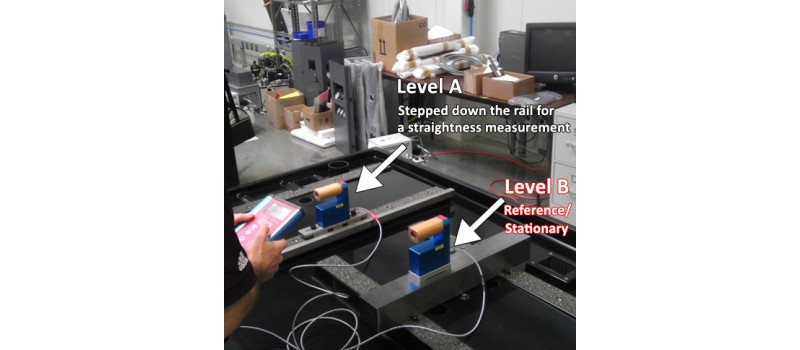Differential leveling is often misunderstood and made more complicated than necessary. It is essentially as easy as A-B and critical to high precision straightness (line) or flatness (surface) measurements. Keep in mind when we talk of straightness or flatness we are not talking about the angle the surface is sitting at compared to the center of Earth’s gravity. While it is better to have the surface as “level” as possible before conducting a flatness measurement for several reasons, it is not the same thing as flatness. Flatness is concerned with the overall error (usually expressed as a height) from the lowest to highest point of the measured surface.
When the flatness of a surface plate or the straightness of a line or machine guide way is needed, the accepted practice is to use 2 levels in tandem differentially to achieve greater stability and accuracy of measurements. This technique is used with Wyler Levels, Mahr Federal Levels and many other brands.
I often tell customers to simply think of a differential level setup as a filtering system. Since the level’s results are being taken differentially, if a vibration or some other disturbance is felt by both levels simultaneously (i.e. forklift driving by or an entire machine surface tilts when the machine table is extended) that erroneous data is filtered out of the equation.

Here I am performing a differential straightness measurement recently at a customer’s facility in NH.
Example:
Level A is sitting at 3 arc seconds and Level B (reference) is sitting at 0 arc seconds:
A – B = Result, 3 – 0 = 3 arc seconds
Uh-Oh! The entire surface just shifted 5 arc seconds! However, since we are measuring differentially, both levels receive the same, errant 5 arc second displacement simultaneously on their pendulums and….
8 – 5 = 3 arc seconds. We are still getting the proper reading.
Without the Differential “B” Level we would get an erroneous flatness/straightness reading of 8 arc seconds.
Here are some tips to keep in mind when utilizing differential leveling:
- Do not disturb the reference level until the entire measurement along a specified line is completed. Since you are using the B level as your reference if you move it before the line is complete your results will be compromised. Today’s software will often tell you when to move the reference level.
- Keep the centerlines of your levels parallel and the levels facing in the same direction
- Don’t use the “B” level as your “dynamic” or level to be moved along the surface plate or line/guide way. If you do, your results will be inverted. This could cause you to lap (reduce) a surface that is already low to begin with!
If you have any further questions or comments feel free to give us a call or send us an email.


Comments